Art of the Early China and Korea 7001279 Ce
Contact between Korea and Cathay goes back to mythology and prehistory. Trade developed from the Bronze and Fe Ages with raw materials and manufactured appurtenances going in both directions for centuries thereafter. In improver to traders, migrants came, outset with those escaping from the quaternary-century BCE conflicts of the Warring States period, and a regular stream of diplomats, monks, and scholars travelled in both directions, too, then that Chinese culture spread to the whole of the Korean peninsula. Writing, religion, ceramics, coinage, agricultural practices, sculpture, and architecture were merely some of the elements ancient Korea captivated from its powerful neighbor, frequently adding their own unique cultural postage stamp and sometimes even outdoing their teachers.
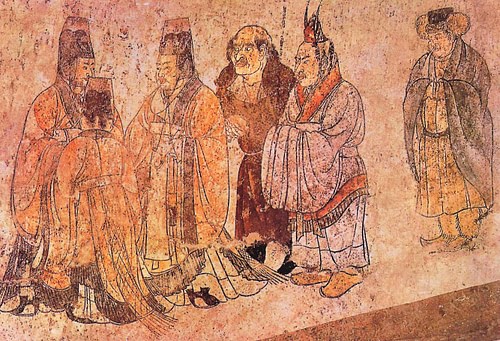
Korean Ambassadors to the Tang Court
The complex and sometimes subtle relationship between ancient China and Korea over the centuries is ably summarised by the historian M.J. Seth as follows:
People's republic of china provided the model for literature, fine art, music, architecture, dress, and etiquette. From China Koreans imported about of their ideas near government and politics. They accustomed the Chinese worldview in which Red china was the centre of the universe and dwelling of all civilization, and its emperor the mediator betwixt heaven and earth. Koreans took pride in the adherence to Chinese cultural norms...they accustomed their country's part as a subordinate member of the international hierarchy in which Mainland china stood at the apex, loyal adherents of Chinese civilization such as Korea ranked next, and the barbarians outside Chinese civilization stood at the bottom. Close adherence to civilized standards was a source of pride. But this did not result in a loss of separate identity...Nor did Korea'southward membership in the "tributary organization" in which the Korean male monarch became a vassal of the Chinese emperor mean that Korea was less than fully independent...In fact, Koreans were fiercely independent...Korea'due south position equally a tributary country was usually ceremonial, and for Koreans information technology did non imply a loss of autonomy. Chinese attempts to interfere in domestic affairs were met with opposition. (4-5)
To better understand this three-stranded relationship of politics, commerce, and culture, it is necessary to examine each of the historical periods of ancient Korea in plough as political developments in the peninsula and Cathay would both strengthen and strain the relationship in equal measure over more a millennium of international relations.
Get-go Relations - Gojoseon
Archaeology has revealed that the Korean peninsula received material culture – notably metalworking skills and rice cultivation – from migrating tribes from Manchuria, Siberia, and China in the Neolithic menstruation. Korean mythology describes the earliest contact with China as when the sage Gija (Jizi to the Chinese) and 5,000 followers left Communist china and settled in Dangun's kingdom of Gojoseon, Korea's start state. When Dangun decided to retreat to a life of meditation on a mountaintop, Gija was made king in 1122 BCE. The myth may represent the inflow of Fe Age culture to Korea. The historical rulers of Gojoseon did adopt the Chinese championship wang (king) illustrating an early influence from neighbouring Yan Prc, probably a trade partner, perhaps with Gojoseon interim as middleman between People's republic of china and the southern states of Korea. Another indicator of trade relations is the discovery of Chinese crescent knife coins (mingdaoqian) at diverse Korean sites.
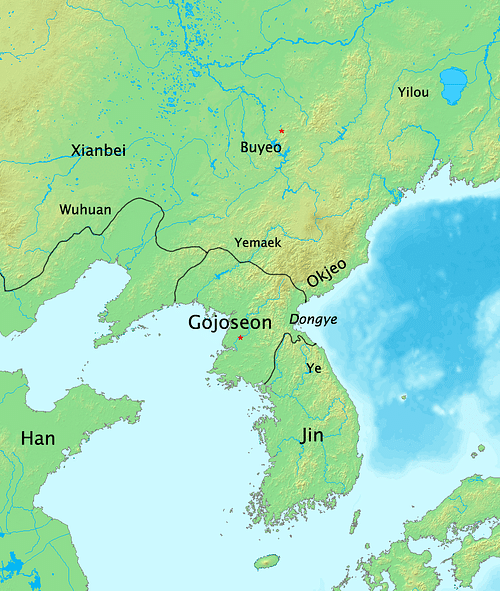
Map of Korean States in 108 BCE
Archaeological prove of Chinese cultural influence is possibly best seen in the use of pit burial tombs in the Daedong River area and the frequent presence of horse trappings and luxury goods therein. The tombs are also of interest as several contain over 100 slaves buried with and presumably belonging to the occupant. With better iron tools introduced from China, farm production increased and so the general prosperity of Gojoseon.
Chinese culture was brought directly to Korea by refugees fleeing the 4th-century BCE conflicts of the Warring States period. The Chinese Han dynasty (206 BCE - 220 CE) established four armed forces colonies, referred to as commanderies, in Manchuria and northern Korea. These prospered on trade and brought Korea into the wider political sphere of Han-dominated East asia. Lasting until the fourth century CE, the near important in terms of population and resources was Lelang (aka Nangnang, 108 BCE - 313 CE). Their presence greatly increased material contact betwixt China and Korea, populated every bit they were past expatriate Chinese (huachiao or huaqiao) supplied with all the appurtenances they were used to enjoying back home.
Chinese culture was brought directly to Korea by refugees fleeing the 4th century BCE conflicts of the Warring States period.
3 Kingdoms Period
The Three Kingdoms period (1st century BCE to 7th century CE) sees the offset of recorded history in ancient Korea. These centuries saw the kingdoms of Baekje (Paekche), Goguryeo (Koguryo), and Silla, and the Gaya (Kaya) confederation, in a continuously shifting political landscape of mutual alliances and conflict betwixt each other and China with the aim of territorial expansion. Despite these conflicts, trade and cultural commutation betwixt the peninsula and China continued and increased. The Iii kingdoms period, then, was a time when the Korean states were able to take advantage of the 4 centuries of political fragmentation that China suffered betwixt the autumn of the Han in the early on 3rd century CE and the rise of the Sui dynasty from 581 CE and push forwards to achieve their own cultural evolution by absorbing and adapting the best cultural and political practices of ancient Mainland china.
Baekje & Gaya
Early relations between the Gaya confederation and Han China is evidenced by 1st-century CE Chinese coin finds at Bon-Gaya and by the presence of the sloping kiln used by Gaya potters. Iron, gold, and horses went to China, and silk, tea, and writing materials came in the other direction. In that location were close cultural ties too, with the Koreans adopting the Chinese writing system and the Chinese kingly title of wang being adopted by Baekje monarchs from the 3rd century CE. Literature, burial practices, and elements of art were passed on, too.
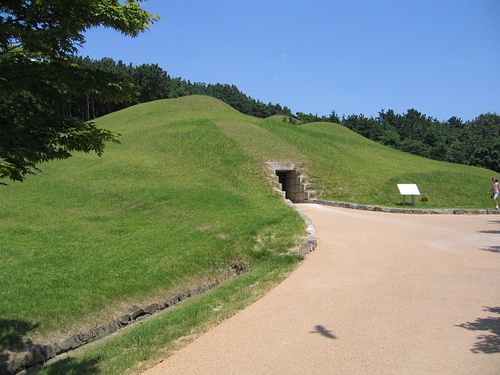
Tomb of Muryeong-Wang
The Korean states, traditionally practitioners of shamanism, adopted start Confucianism, then Taoism and Buddhism from China making the latter the official state religion. The Baekje kingdom officially adopted Buddhism (which had originated in India just acquired distinctly Chinese elements) in 384 CE later its introduction in that location past the Indian/Serindian monk Marananta. Confucianism would greatly influence Korean club, politics, ethical idea, and family relationships, while Buddhism, besides becoming the nearly widely practised religion, would have a tremendous touch on art, architecture, literature and ceramics.
Goguryeo, situated as it was in the north, diameter the burden of the political ambitions of China'south new dynasty, the Sui (581- 618 CE).
Goguryeo
The northern Goguryeo kingdom was a frequent trading partner of China'south, with the onetime exporting golden, argent, pearls, and textiles while China sent weapons, silk, writing materials in return. There were also shut cultural ties between the 2, with Goguryeo adopting the Chinese writing system, wuzhu coins (known locally as oshuchon), Chinese verse style, architectural elements (especially regarding tombs), art motifs (again seen in tombs such every bit constellations painted on ceilings and images of the Chinese animals of the four directions), and belief systems. In 372 CE a National Confucian Academy was created and Buddhism was adopted as the official country faith (replacing the predominant Shamanism) when it was introduced by the monk Shundao (Sundo to the Koreans).
Goguryeo, situated as it was in the northward, bore the brunt of the political ambitions of China'due south new dynasty, the Sui (581-618 CE). A Chinese combined navy and army of 300,000 attacked in 598 CE, actually in response to a Goguryeo pre-emptive strike, but was defeated largely by weather conditions. Some other attempt was made in 612 CE only was once more unsuccessful following the Battle of Salsu River where the Koreans were ably led past the famous full general Eulji Mundeok. Co-ordinate to legend, of the 300,000-strong Sui army only 2,700 returned to China. The upper-case letter Pyongyang withstood a lengthy siege and Goguryeo stood firm. Two more than attacks nosotros rebuffed in 613 and 614 CE and Goguryeo built a 480 km (300 miles) long defensive wall in 628 CE so as to deter whatsoever further Chinese ambitions. The defeats would contribute to the fall of the Sui dynasty, but their successors, the Tangs, proved just as ambitious for territorial expansion and rather more effective in achieving it.
Silla
In the 4th century CE, the Silla kingdom maintained diplomatic relations with China, paying regular tribute to the regional powerhouse. From the 6th century CE, Silla rulers also adopted the Chinese wang title, the Chinese writing system, Confucianism, and Buddhism. The latter became the official state religion in 535 CE, even if traditional shamanistic practices continued too, equally in the other states. When Taoism became more popular during the Tang catamenia (618-907 CE), and so too it became more widespread in the Silla kingdom.
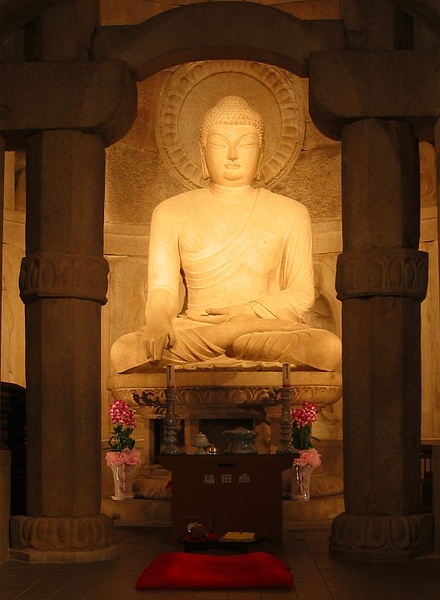
Buddha, Seokguram Grotto, Gyeongju
The two states were long-time trading partners with China exporting silk, tea, books, and argent goods while Silla sent in return gilded, horses, ginseng, hides, ornamental manufactured goods such as tables and slaves. The reigns of Queen Seondeok and king Taejong Muyeol in the mid-seventh century CE saw an even closer relationship with Tang China with Tang court community followed at Kumsong, students sent to People's republic of china for written report, and about significantly of all, massive military aid beingness sent to assist Silla quash their rival kingdoms. Emperor Gaozong sent a navy of 130,000 men in the hope that Silla would defeat the other states and so could itself be destroyed. The Koreans, though, had other plans. While the Tangs were preoccupied with a rising Tibet, the Silla armies battled the Chinese forces remaining in Korea. Battles at Maesosong (675 CE) and Kibolpo (676 CE) brought victory and finally, Silla was the sole master of Korea.
Unified Silla Kingdom & Balhae
Despite the Silla kingdom's refusal to become just another Chinese province, relations with China were non soured, in fact, the young Korean state became a loyal ally. The influence of Chinese culture connected to be significant and both Confucianism and Buddhism remained an important role of the Silla education system. Buddhism was even so the official country organized religion, practised by all levels of society. The near famous of all Buddhist scholar-monks belongs to this period – Wonyho, who popularised the faith in the 7th century CE. If annihilation, Confucianism became stronger in the Unified Silla with a National Confucian Academy established in 682 CE and an examination for land administrators introduced in 788 CE.
There was a healthy merchandise between the two states as well with Chinese luxury appurtenances such as silk, books, tea, and fine art being imported while Korea exported metals (especially gilt and silver), ginseng, hemp goods, manufactured goods, horses, and sent students and scholars to Red china. There were even Silla controlled trading areas in Chinese territory, such was the volume of merchandise.
Gimmicky with the Unified Silla Kingdom, but occupying territory in the n of the Korean peninsula and Manchuria, was the state of Balhae (aka Parhae, 698-926 CE). Balhae, although at times trading with its neighbours, unwisely attacked both Silla and Tang China in the first half of the 8th century CE, which compelled the two to in one case more form an alliance to quash a mutual enemy. This time, however, the northern mountains proved too hostile an environment and the joint Silla-Tang expedition failed spectacularly with Silla losing half of its regular army amidst the snowy peaks. The Balhae kingdom continued to prosper thanks to its close relations with Nippon, simply in the early on 10th century CE the stop swiftly came when information technology was attacked and conquered past the Mongolian Khitan tribes. Its territories and those of the declining Silla kingdom would exist taken over by Korea'due south new rising power, the Goryeo dynasty.
Goryeo Dynasty
The Goryeo (Koryo) dynasty, after another circular of inter-state fighting known as the Later on Three Kingdoms catamenia (889-935 CE), conquered the whole of the Korean peninsula. As in previous times, a respect for Chinese civilization and ability to practise its ethics connected to be a marker of gentility amongst the Korean elite. As Goryeo'south founder Taejo declared, "Nosotros in the Eastward have long admired Tang ways. In civilization, ritual, and music, nosotros are entirely following its model" (Portal, 79).
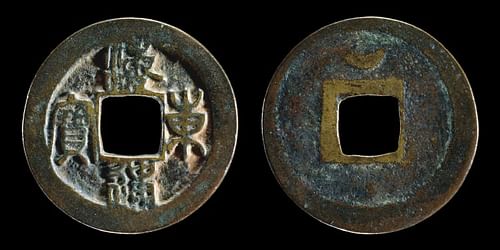
Statuary Korean Coin, Goryeo Dynasty
Goryeo after established even stronger ties with People's republic of china's Vocal dynasty (960-1279 CE). The Vocal took advantage of these friendly relations and requested that Goryeo help them deal with the Khitan and Jin, but the Koreans were non keen to be embroiled in a wider regional conflict. Tribute was paid to Red china, but both land-sponsored and private trade included all manner of goods moving in both directions. China exported silk, books, spices, tea, medicine, and ceramics while Goryeo sent gold, silver, copper, ginseng, porcelain, pino nuts, and hanji paper. Such were the number of goods available that in the 13th century CE Songdo, the Goryeo capital, boasted over 1,000 shops.
Cultural ties were also potent with Chinese literature beingness very popular, and the state administration modelled on the Chinese approach with a civil service examination introduced in 958 CE and Confucian principles followed. Buddhism remained the state faith with many more temples and monasteries beingness built. In this period Korea began to mint its own coinage which imitated those of the earlier Tang dynasty. Even the 'heavy coin of the Qianyuan period' inscription was translated from the Chinese (Qianyuan zhongbao) to the Korean Konwonchungbo. The Goryeo mint did add an identifying mark such as 'Eastern kingdom' (Tongkuk) on the reverse side of their coins but, as with Chinese coins, the Korea coins had a square fundamental hole.
Afterward History
A new threat to Korea emerged in the early 13th century CE when the Mongol tribes, united by Genghis Khan (Chinggis), swept through China and conquered Beijing in 1215 CE. Then in 1231 CE, the Mongols, now led by Ogedei Khan, turned their attention to Korea, forcing Goryeo to move its capital letter. In that location would be vi more Mongol invasions over the adjacent three decades, but past 1258 CE peace was fabricated. The cost was an obligation for Goryeo to provide ships and materials for the (failed) Mongol invasions of Nippon in 1274 and 1281 CE. Korea so became increasingly influenced by Mongol culture, princes were required to live as hostages in Beijing and several kings married Mongolian princesses. Korea would take to wait another century to re-found its independence when, in 1392 CE, the new state of Joseon was formed.
This content was made possible with generous support from the British Korean Lodge.
This article has been reviewed for accuracy, reliability and adherence to academic standards prior to publication.
Source: https://www.worldhistory.org/article/984/ancient-korean--chinese-relations/